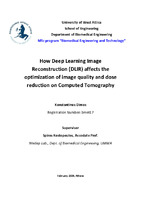How Deep Learning Image Reconstruction (DLIR) affects the optimization of image quality and dose reduction on Computed Tomography
Πώς o αλγόριθμος ανακατασκευής εικόνας βαθιάς μάθησης (DLIR) επηρεάζει την τη βελτιστοποίηση της ποιότητας της εικόνας και τη μείωση της δόσης ακτινοβολίας στην υπολογιστική τομογραφία

Μεταπτυχιακή διπλωματική εργασία
Συγγραφέας
Δήμος, Κωνσταντίνος
Ημερομηνία
2024-02-29Επιβλέπων
Kostopoulos, SpirosΛέξεις-κλειδιά
Iimage quality ; Ultra-low dose ; Deep learning image reconstruction ; Anthropomorphic phantomΠερίληψη
The aim of this study is to investigate the influence of deep learning-based
reconstruction (DLIR) on image quality across varying dose levels within a Chest-
Abdomen-Pelvis (CAP) protocol using a 512-slice CT scanner and an advanced
anthropomorphic phantom. Comparative analysis between DLIR, Adaptive
Statistical Iterative Reconstruction (ASIR-V), and conventional Filtered
BackProjection (FBP) reconstructions was conducted at normal, low, and ultra-low
dose levels.
The CT scanner employed in this experiment is the Revolution APEX by GE
HealthCare (Waukesha, WI, USA). The experiment involves the use of a dedicated CT
whole-body phantom, the PBU-60 by Kyoto Kagaku. A quantitative analysis was
conducted, comparing the FBP Normal Dose (ND) and various reconstruction
algorithms across three distinct dose levels (normal, low and ultra-low dose) and
chest/abdomen/pelvis regions. Furthermore, an additional quantitative assessment
was included, using ASIR-V60% as a reference due to its widespread utilization,
between ASIR-V90% and DLIR-H. Also, a qualitative analysis performed to evaluate
the general image quality and overall contrast of ASIR-V60%, ASIR-V90% and DLIR-H.
The evaluation was carried out in terms of Signal-to-Noise Ratio (SNR) and Contrastto-
Noise Ratio (CNR).
The results highlight the feasibility of a low-dose protocol and suggest the potential
introduction of an experimental ultra-low-dose protocol for CAP. The proposed
implementation relies on the use of a deep-learning-based image reconstruction
algorithm, which aims to maintain image quality and contrast levels comparable to
those typically observed with conventional reconstruction algorithms used in regular
and low-dose protocols.

